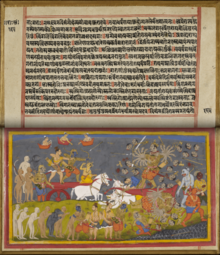 Global Information
Global InformationRamayana information
| Rāmāyaṇa | |
|---|---|
 Rāma slaying Rāvaṇa, from a royal Mewar manuscript, 17th century | |
| Information | |
| Religion | Hinduism |
| Author | Valmiki |
| Language | Sanskrit |
| Period | 8th century BCE–3rd century CE |
| Chapters | 500 Sargas, 7 Kandas |
| Verses | 24,000 |
| Full text | |
| Part of a series on |
| Hinduism |
|---|
 |
|
|
The Ramayana (/rɑːˈmɑːjənə/;[1][2] Sanskrit: रामायणम्, romanized: Rāmāyaṇam[3]), also known as Valmiki Ramayana, as traditionally attributed to Valmiki, is a smriti text (also described as an Sanskrit epic) from ancient India, one of the two important epics of Hinduism known as the Itihasas, the other being the Mahabharata.[4] The epic narrates the life of Rama, a prince of Ayodhya in the kingdom of Kosala. The epic follows his fourteen-year exile to the forest urged by his father King Dasharatha, on the request of Rama's stepmother Kaikeyi; his travels across forests in the Indian subcontinent with his wife Sita and brother Lakshmana; the kidnapping of Sita by Ravana, the king of Lanka, that resulted in war; and Rama's eventual return to Ayodhya along with Sita to be crowned king amidst jubilation and celebration.
The scholars' estimates for the earliest stage of the text ranging from the 7th to 4th centuries BCE,[5][6] and later stages extending up to the 3rd century CE,[7] although original date of composition is unknown. It is one of the largest ancient epics in world literature and consists of nearly 24,000 verses (mostly set in the Shloka/Anuṣṭubh metre), divided into seven kāṇḍa (chapters). It belongs to the genre of Itihasa, narratives of past events (purāvṛtta), interspersed with teachings on the goals of human life.
There are many versions of the Ramayana in Indian languages, besides Buddhist, and Jain adaptations. There are also Cambodian (Reamker), Indonesian, Filipino, Thai (Ramakien), Lao, Burmese, Nepali, Maldivian, Cambodian, Vietnamese, Tibeto-Chinese, and Malay versions of the Ramayana.[note 1]
The Ramayana was an important influence on later Sanskrit poetry and the Hindu life and culture, and its main figures were fundamental to the cultural consciousness of a number of nations, both Hindu and Buddhist. Its most important moral influence was the importance of virtue, in the life of a citizen and in the ideals of the formation of a state (from Sanskrit: रामराज्य, romanized: Rāmarājya, a utopian state where Rama is king) or of a functioning society.
- ^ "Ramayana" Archived 4 November 2015 at the Wayback Machine. Random House Webster's Unabridged Dictionary.
- ^ "Ramayana | Meaning of Ramayana by Lexico". Lexico Dictionaries | English. Archived from the original on 19 February 2020. Retrieved 19 February 2020.
- ^ The Rámáyan of Válmíki.
- ^ "Ramayana | Summary, Characters, & Facts". Encyclopedia Britannica. Archived from the original on 12 April 2020. Retrieved 18 February 2020.
- ^ Goldman 1984, p. 20–23.
- ^ Cite error: The named reference
Mumbai mirrorwas invoked but never defined (see the help page). - ^ Cite error: The named reference
Brockington1998was invoked but never defined (see the help page). - ^ Malwa), Bhojarāja (King of (1924). Champu-Ramayana (in Sanskrit). Pandurang Jawali.
- ^ Mukherjee, P. (1981). The History of Medieval Vaishnavism in Orissa. Asian Educational Services. p. 74. ISBN 9788120602298. Archived from the original on 1 February 2023. Retrieved 6 January 2017.
- ^ Living Thoughts of the Ramayana. Jaico Publishing House. 2002. ISBN 9788179920022. Retrieved 6 January 2017.
- ^ Krishnamoorthy, K.; Mukhopadhyay, S.; Sahitya Akademi (1991). A Critical Inventory of Rāmāyaṇa Studies in the World: Foreign languages. Sahitya Akademi in collaboration with Union Academique Internationale, Bruxelles. ISBN 9788172015077. Retrieved 6 January 2017.
- ^ Bulcke, C.; Prasāda, D. (2010). Rāmakathā and Other Essays. Vani Prakashan. p. 116. ISBN 9789350001073. Retrieved 6 January 2017.
Cite error: There are <ref group=note> tags on this page, but the references will not show without a {{reflist|group=note}} template (see the help page).